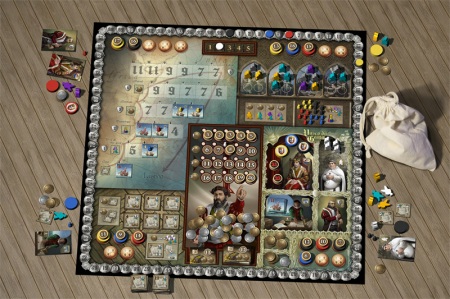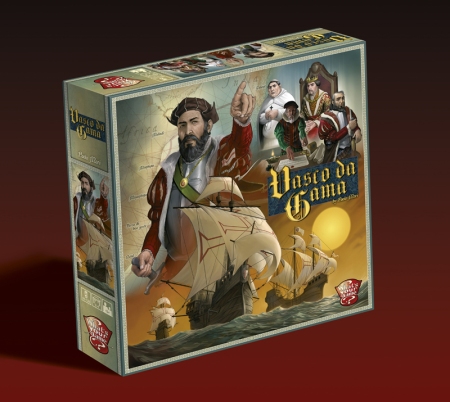Review: Vasco Da Gama
Posted by James (admin) on December 15th, 2009
 In Vasco Da Gama, players are each preparing ships and setting sail for the New World to earn victory points. In essence, Vasco Da Gama is a worker placement game played over 5 rounds. Each round players place their 4 (sometimes 5) action disks on one of the 4 areas so they can perform the relevant actions, and then they resolve these actions. However, the system that determines the order in which the actions actually occur is very clever and is the central and unique feature of Vasco Da Gama.
In Vasco Da Gama, players are each preparing ships and setting sail for the New World to earn victory points. In essence, Vasco Da Gama is a worker placement game played over 5 rounds. Each round players place their 4 (sometimes 5) action disks on one of the 4 areas so they can perform the relevant actions, and then they resolve these actions. However, the system that determines the order in which the actions actually occur is very clever and is the central and unique feature of Vasco Da Gama.
I recommend reading the rules for the full details but I’ll give an outline of the game. There are 4 main actions to take: Recruiting crew and captains, Attaining projects, Setting sail, and using the special characters. (If you don’t use an action you can choose take 1 to 3 reals from the bank instead – the higher the action number, the greater the amount of reals.)
RECRUITING CREW
Recruiting crew allows players to buy crew for reals (cash) – the more crew bought in one transaction, the more it costs. Plus, a player can also buy a captain too costing as many reals as the number of crew bought. Any crew purchased must be of different colours and a purchase is made from one of the groups for sale. So, there are some tactics to purchasing what you need.
 ATTAINING PROJECTS AND SETTING SAIL
ATTAINING PROJECTS AND SETTING SAIL
Projects are the ships that will sail to the New World. Each has 3 important factors written on them: the amount of (differently coloured) crew required to set sail, the income (points and/or cash) it will generate whilst sailing, and the ship’s rating. The Projects action allows a player to gain project tiles, and a player with the required crew (plus a captain) can use the Set Sail action to turn a project into a launched ship. Along the coast of the New World are several ports – each with a set of spaces where ships can be placed (see picture). Each box has a number (between 4 and 11) on it and the player’s ship can be placed on any empty box which has a rating equal to or lower than the ship’s rating. The player scores victory points as well as a bonus (free crew, free captain, 2 gold, etc. depending upon the port) for the initial placement. At the end of a round, ships that are sailing earn income – points and/or cash. Plus, any rows that are full earn victory points for each ship and then sail up to the next port (highest rating first). If there are no more free spaces left at the next port (or the ship’s rating isn’t high enough to enter a space), the ship is removed and the captain returns to its owner.
SPECIAL CHARACTERS
The powers of the special characters can each only be used once per round. One character gives the player white sailors (the only way to launch a ship requiring 5 different colour sailors); one character gives the player 2 victory points and first player status; one character gives a free ship (which earns the launching bonus but not the on-going bonuses); one character gives an extra action; and, one character allows the player to take a large of small cash amount.
 ACTION SEQUENCE
ACTION SEQUENCE
So, what is the clever turn sequence system? In the centre of the board is a group of wooden discs with the numbers 1 to 20 on them in order (see picture). Each of the 4 areas where actions can be executed have spaces where action discs can be placed – the number of spaces is based on the number of players. Going clockwise around the table, players place one of their action discs on a free action space, plus they take any one of the remaining numbered discs and place it on top of that action disc. When all the players have placed all of their action discs, the actions will be resolved in number order.
The clever part is that there is a cost marker on one of the 20 spaces – any actions whose value is equal to or greater than this number are free to perform; however, any actions performed prior to this marker cost 1 real for each number lower than the marker they are. So, if the cost marker is at 8 then all actions from 8 onwards will be free, an action performed with the number 7 marker on it will cost 1 real, action 6 will cost 2 real and so on. To make it harder, once all wooden discs and actions have been placed, the position of the cost marker will move up to 3 spaces in either direction.
This makes the planning of actions very interesting and requires some thought. Not only does a player need to select which actions and the order in which they wish to perform them but they need to consider what other players will try to do too, and how much they are willing to pay to take their action earlier in the sequence. You also need to factor in, or assess the risks, that cost of actions may go up meaning you wouldn’t be able to afford an action which could spoil the chain of events you had planned.
THOUGHTS
Overall, Vasco Da Gama was thoroughly enjoyable. When I originally read the rules, it sounded like each step was relatively simple but there were a lot of different actions and steps, plus the resources seemed quite inter-linked. Therefore, the game seemed complex by virtue of its mass of mechanics not its difficulty. However, once you start playing Vasco Da Gama it clicks into place and you can concentrate on all the difficult, tense and entertaining decisions. Whilst not directly hostile, player interaction is high because you’re constantly jostling for position on the actions and trying to secure the items you want or deny others.
 Earning cash is very important to your game and is quite difficult as there is no regular income every round – although collecting cash instead of taking an action is a really nice game balancing mechanic. The free money from the special characters never really amounted to very much as players tended to take it as soon as it was financially viable, i.e. pay 5 reals for the action to gain 8 gold and deny another player taking it for a larger gain.
Earning cash is very important to your game and is quite difficult as there is no regular income every round – although collecting cash instead of taking an action is a really nice game balancing mechanic. The free money from the special characters never really amounted to very much as players tended to take it as soon as it was financially viable, i.e. pay 5 reals for the action to gain 8 gold and deny another player taking it for a larger gain.
I enjoyed the fact that points can be earned in a few different ways as this made it possible to adapt and alter your strategy if other players got in the way. You can even use your actions to block others from using that action space plus gain cash. Sometimes, the points you will earn depend on other players’ actions so you need to think about what the best choice might be given your opponents’ reactions.
Replayability seemed to be good too. One player said they had played 3 times now and every game had been different because of where the action cost marker was positioned. The actions in one game were all very cheap; whereas, in our game the actions were generally expensive.
Vasco Da Gama feels like a very active and responsive game. It played relatively quickly and there was little downtime – if your actions are a long way apart, seeing what other players are doing is still engaging. I think Vasco Da Gama is a really strong Eurogame, like Hansa Teutonica, and I definitely want to play Vasco Da Gama some more.
James.
[Played with 4 players]


December 18th, 2009 at 5:38 am
This game looks amazing. It is at the top of my wish list.
December 21st, 2009 at 11:38 am
How does it compare to Endeavor?
December 23rd, 2009 at 1:58 am
That’s a good question. I haven’t played Endeavor yet so unfortunately I can’t comment. I hope to play Endeavor in the coming weeks so as soon as I do, I’ll post a reply.
January 7th, 2010 at 10:19 pm
It’s a completely different game but both games are the top games of 2009